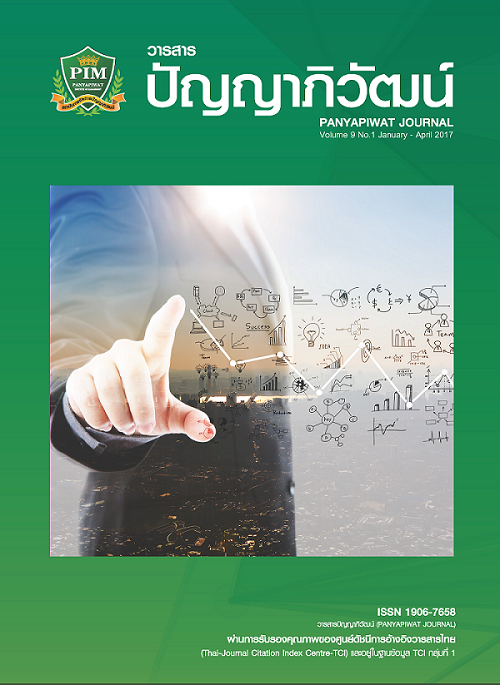การเพิ่มประสิทธิภาพการบริการผ่าน NFC: กรณีศึกษาร้านเบเกอร์รี่และกาแฟ
Main Article Content
Abstract
ในธุรกิจการบริการลูกค้าเป็นกุญแจสำคัญที่ส่งผลต่อกำไรในการทำธุรกิจ ซึ่งธุรกิจแต่ละประเภทนั้นมีข้อจำกัดที่แตกต่างกันไม่ว่าจะเป็นเรื่องพื้นที่ที่จำกัดของทางร้าน ทุนในการทำธุรกิจ หรือแม้แต่จำนวนพนักงานที่ให้บริการลูกค้า เป็นต้น ด้วยข้อจำกัดเหล่านี้ทำให้ธุรกิจต่างๆ พยายามหาแนวทางในการพัฒนาแก้ไขปัญหา เพื่อก้าวข้ามขีดจำกัดของตัวเอง และสามารถแข่งขันกับธุรกิจอื่นได้ อีกทั้งเทคโนโลยีมีความหลากหลายทั้งในเรื่องรูปแบบและราคา ซึ่งราคาในการนำเทคโนโลยีมาใช้นั้นถือว่าเป็นปัจจัยที่สำคัญอีกปัจจัยหนึ่งเช่นกัน เทคโนโลยีการสื่อสารระยะใกล้ หรือ NFC จึงเป็นอีกแนวทางหนึ่งที่สามารถนำมาประยุกต์ใช้เพื่อเพิ่มประสิทธิภาพและประสิทธิผลในการบริการให้กับองค์กรธุรกิจและลูกค้า อีกทั้งตัวเทคโนโลยี NFC นั้นสามารถนำมาประยุกต์ใช้ได้หลากหลายรูปแบบ และมีราคาต่ำ ทำให้องค์กรธุรกิจสามารถประหยัดค่าใช้จ่ายในการนำเทคโนโลยีมาใช้
In Business, Customer service is an important key that affecting the business’s profit. Each business types have different limitation such as space limitation, Budget for doing business, or even staff that servicing customer and so on. With these limitation, many businesses try to find or develop solution to solved the problem in order to go beyond limitation and able to complete with others. Technologies are varies in form and price, which is also a key element in business. Near Field Communication or NFC is one of the solution technology that can apply to increase performance effectively and efficiency for business and consumer. NFC technology can be applied in various form and also low cost which can save the cost of using technology in Business.
Article Details
I and co-author(s) certify that articles of this proposal had not yet been published and is not in the process of publication in journals or other published sources. I and co-author accept the rules of the manuscript consideration. Both agree that the editors have the right to consider and make recommendations to the appropriate source. With this rights offering articles that have been published to Panyapiwat Institute of Management. If there is a claim of copyright infringement on the part of the text or graphics that appear in the article. I and co-author(s) agree on sole responsibility.
References
Ali shehri, A. & Schneider, S. (2013). Formally defining NFC M-coupon requirements, with a case study. The 5th International Workshop on RFID Security and Cryptography.
Church, L. & Moloney, M. (2012). State of the Art for Near Field Communication: security and privacy within the field. Ireland: Escher Group.
Du, H. (2013). NFC Technology: Today and Tomorrow. International Journal of Future Computerand Communication, 2(4), 351-354.
Jan Kremer Consulting Services (2010). Near Field Communication. Retrieved December 20, 2013, from http://jkremer.com/White%20Papers/Near%20Field%20Communication%20White%20Paper%20JKCS.pdf
Monteiro, D. M., Rodrigues, J. J. & Lloret, J. (2012). A secure NFC application for credit transfer among mobile phone. Computer, Information and Telecommunication Systems (CITS), 2012.
Muriira, L. M. & Kibua, N. (2012). Near Field Communication (NFC) Technology: The Future Mobile Money Service for Kenya. International Journal of Computing and ICT Research, 6(1), 73-83.
Na Lamphun, P. & Surapongruktakul, N. (2015). New Technology Trend for Retail Business. Panyapiwat Journal, 7(1), 255-267. [in Thai]
Na Lamphun, P. (2014). Near Field Communication on Smart Phone and Its Application. University of the Thai Chamber of Commerce Journal Science and Technology, 1(1), 11-24.[in Thai]
Triggs, R. (2016). All you need to know about NFC Tags. Retrieved Dec 14, 2016, from http://www.androidauthority.com/nfc-tags-explained-271872/


